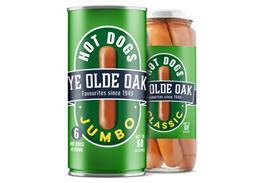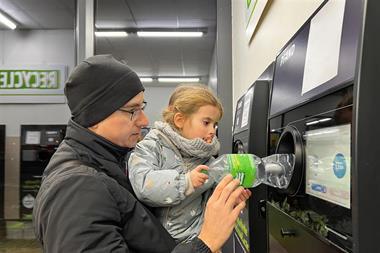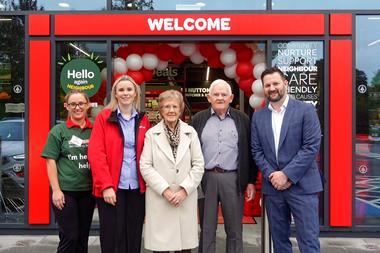
Last week I joined Association of Convenience Stores study in Cork, Ireland to visit a wide range of convenience stores and supermarkets with a delegation of over ninety retailers and suppliers. While most delegates were on the trip to see the execution of best-in-class in-store food service that Irish convenience store operators are famous for, I was there to see the operation of Ireland’s recently launched deposit return scheme (DRS).
I couldn’t miss the opportunity to see DRS in action so close to the UK market, with a view to learning lessons that might help with the design and implementation of DRS for UK retailers. Here are my key takeaways from my visit to Cork (including some photos and film clips) and some observations about what the future UK scheme can learn from the design of the Irish model.
Visibility and Communications
DRS is delivered in Ireland by the deposit management organisation Re-Turn that, from the outside at least, appear to be doing a great job at implementing DRS. My first observation is that it was easy to see DRS in operation in every store. The Re-turn branding was visible, and the messaging was clear. Communication and awareness of the scheme is so important for DRS when we are asking consumers to fundamentally change their recycling habits.
Delivery of communication assets in-store is also a good sign of collaboration between Re-turn and retailers operating return points. The Re-turn brand looked professional, the messaging was clear and there were campaign assets everywhere, meaning they got the branding out to retailers early! Pop-up stands, shelf edge labels, aisle markers and posters (see photos below), you could not fail to see it.
The Transition Period
That said, the Irish DRS scheme is in the difficult transition phase that all schemes must navigate. DRS went live on 1st February, but there is still a mix of products on shelves that have the Re-turn logo and a deposit applied, and others that have no logo and no deposit applied. So, despite the excellent visibility of DRS, consumer must still pay close attention to what products have the deposit applied.
Undoubtedly this is causing confusion for consumers, store colleagues and frustration for retailers during the early stages of DRS. The transition period in Ireland runs to June 2024 with retailers required to only purchase products with Re-turn logos from the end of March 2024.
One advantage the Irish market has in managing the transition compared the UK market is the widespread use of electronic shelve edge labels. Without the electronic shelve edge labels it will be tough and resource intensive to keep up to speed with what suppliers have registered their products and applied logos and therefore need a deposit applied.
It seems to me that policy makers in the UK are going to have to facilitate close collaboration between retailers and suppliers about the registration of products and application of deposits on products to avoid consumer confusion. There will also need to a pragmatic approach to any enforcement activity during the transition period. The timing of the DRS go-live will be essential too, avoiding busy trading periods for retailers.
The Hardware
Different sites will need different DRS infrastructure, but manual return points don’t look to be a viable option for anyone. I saw RVMs at a large supermarket site (SuperValu car park), a forecourt site (Daybreak) and a neighbourhood convenience store site (Centra) - each with a different kind of RVM. I won’t bore you with RVM specifications, but, obviously, larger sites require large RVM infrastructure to handle higher volumes of returns.
All the sites I saw had put in place provisions to manage residual liquid in containers and bins for rejected containers for the initial introduction of the scheme. This seems sensible given the mix of compliant and non-compliant products on shelves, and consumers that are unfamiliar with how to use RVMs and handle containers.
From talking to Irish retailers, it was clear that no one thought a manual return system would work - it’s too messy, time consuming, labour intensive and a food hygiene and safety risk in stores. Thankfully there is clear exemption criterion in place. If your site is below 250 sqms of internal sales space, you qualify to apply for an exemption. If you get approved for exemption, you must display an exemption certificate in stores with a QR Code allowing consumers to find an alternate return point.
Exemptions and Support
I visited sites that had an exemption because the site was too small and serving mainly transient customers. I also visited a site that was under the 250sqm exemption threshold but still offered a reverse vending machine. Why? The retailer was very clear - the profile of customers and competitors in the areas meant it was necessary to offer the return point.
This shows the complex local dynamics that will determine the provision of return points and why we need to give retailers the ability to decide if it is viable to host a return point. Anyone that has worked with me on DRS will have heard me say many times “we need to strategically map return points” through a clear exemption criteria.
It’s also worth noting that the Irish DRS offers retailers operating RVMs, taking back less than 250,000 containers per year, a £6,000 grant towards funding machines. This is something that the UK government should strongly consider. If the government and the deposit management organisation want a widespread network of return points, and a positive experience for consumers, they must help smaller retailer sites invest in RVMs.
Retailer Concerns
For all the praise I have given the Irish DRS, I should also be clear that we heard considerable frustration from retailers about the implementation of the scheme. While on the store tour, Irish retailers shared their frustration about the confusion caused by the transition period. Before heading out to Ireland, I had also heard some frustration about the registration process for retailers and clarity on exemption criteria and support.
Let’s be clear, implementing a DRS is not easy and we should not be aiming for perfection. It seems these frustrations are legitimate but also an inevitability when such a fundamental change is implemented. The only solution is to give a deposit management organisation, like Re-turn or others, as much lead time as possible to prepare their systems, teams and resources.
Key Lessons
The transition period is tough. Careful consideration of the timing of the DRS go-live date is needed so retailers can run down old stock and suppliers can put deposit laden stock on shelves in a short space of time.
Shelf edge communications during the transition period needs to be managed carefully. There will be a resource intensive time for retailers to make customers aware of what products have deposits applied. Stores will need to be awash with clear communications and stores colleagues briefed on the changes.
Manual return systems don’t look viable. Manual returns are messy and high-risk for small retail sites. So, support will be needed to invest in RVMs, and a clear exemption policy based on store size and format will be needed.
DRS is not easy. There will not be a perfect DRS implementation. However, a well-resourced and equipped deposit management organisation will make it easier. To achieve this, the DMO will need time to get itself set up properly.
I’m keen to hear from retailers in Ireland about their experience of DRS! What is working and what isn’t? Please leave a comment, drop me a message on LinkedIn or email: Edward.woodall@acs.org.uk
































No comments yet